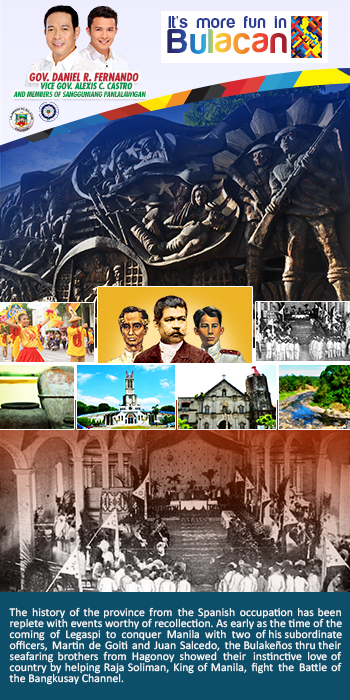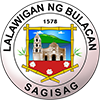General Info
Basic Information you need to know about Bulacan
Josefina Mendoza dela Cruz (1998-2007)
 If there is one very significant realization that the movie Jose Rizal brought to the fore-when it took the nation by storm, and moviedom as well just some weeks ago—it would be that the fire and spirit that sparked the Philippines revolution still live in the hearts of the many Filipinos. From the warm and emotional-fused recognition it received from the public, it becomes apparent that all did not end after the fireworks were unleashed into thin air amidst the hullabaloo and the merry-making on June 12, 1998. That such dogma is what keeps Bulacan province in its rightful destination and always on top of thins. As the newly-elected governor of the historically and culturally-rich province of Bulacan, she emphasizes the fact that history plays a vital role in every endeavor that Bulakeños undertake and it is the very bedrock to which the Bulacan vision is anchored on.
If there is one very significant realization that the movie Jose Rizal brought to the fore-when it took the nation by storm, and moviedom as well just some weeks ago—it would be that the fire and spirit that sparked the Philippines revolution still live in the hearts of the many Filipinos. From the warm and emotional-fused recognition it received from the public, it becomes apparent that all did not end after the fireworks were unleashed into thin air amidst the hullabaloo and the merry-making on June 12, 1998. That such dogma is what keeps Bulacan province in its rightful destination and always on top of thins. As the newly-elected governor of the historically and culturally-rich province of Bulacan, she emphasizes the fact that history plays a vital role in every endeavor that Bulakeños undertake and it is the very bedrock to which the Bulacan vision is anchored on.
History would recount that Bulacan was the wellspring of some of our country's noble heroes like Francisco Balagtas (old town of Bigaa), Marcelo H. del Pilar and his nephew, Gregorio H. del Pilar (town of Bulacan). Its once breath-taking scenery of lush greenery and clean rivers provided shelter to some of the most intelligent minds behind the revolution at one time or another, Emilio Aguinaldo's revolutionary government sought refuge in Biak-na-Bato, in the foothills of Sierra Madre in San Miguel, Bulacan.
Calumpit, a town in the northern part of Bulacan was the scene of the decisive battle of the Philippine-American War where the army, headed by General Antonio Luna staged the historical three-week heroic resistance that paved the way to the beginning of the guerrilla war.
Pandi and San Rafael became cauldrons of insurrectionary activities undertaken by the revolutionaries.
The town of Malolos would forever be a significant part of the Philippines Independence when it served as the fountainhead of the Malolos Congress that eventually established the first constitutional republic in Asia, the Philippines Republic.
Just recently, Bulacan was chosen as the inaugural site of the centennial celebrations as well as the historical swearing-in of the 13th President of the Philippines, President Joseph Estrada, in the Barasoain Church, in the lively and colorful town of Malolos, Bulacan.
So much has changed in this historical haven so the next 100 and so years. Fast forward, the province of Bulacan at present is home 1.8 million Bulakeños. A total of 24 towns and 564 baranggays are sprawled on its immense 262,500-hectare land. Literacy rate in the province is recorded at 98-57% while the unemployment rate is 9.9%.
Since Bulacan is just a few hours drive away hours drive away from the hub of Manila, it is never left behind in terms of road infrastructures as well as telecommunication, power and water supply facilities. Industrial estates also abound in the area.
A leisurely drive along some of the streets in the key towns in Bulacan would prove that it is indeed one of the most progressive and highly developed urbanizing province in the country.
“If we will go by indicators, Bulacan apparently enjoys the honor of being among the top provinces in the Philippines and is third highest in terms of per capita income,” shares Governor Josie dela Cruz.
Bulacan holds the distinction of being an entrepreneurial community where micro finance livelihood is the name of good business. The local government provides support to small-scale businesses and a considerable amount of the province's income is generated through its active “Cooperatives are the backbone are of Bulacan's economy” shares the newly elected governor in an afternoon interview with the Graphic.
Consequently, the local government has designed as the Provincial Cooperative Consultant Conference, which is aimed at improving the condition of the cooperatives in Bulacan. Networking in terms of COOP consolidation and federation building is likewise being done to help strengthen market linkages.
For the meantime, the Office of the Governor has three is the cleanliness drive throughout Bulacan. It is noticeable how the province has successfully expunged its so called eyesores. The capitol, which is considered to be a symbol of every Bulakeno, is undergoing rehabilitation.
The obliteration of various squatter colonies is included in this drive as well. They were provided their own decent quarters.
The poor drainage system, which accounts for the easy flooding of some of the streets in Bulacan, is also being addressed.
The second priority of the governor is to upgrade their medical services by making hospitals viable, efficient, and effective and by increasing the competence levels of doctors, nurses and other hospital staff.
“In addition, I put importance on the availability of medicine in hospitals 24 hours a day,” states the young lady governor.
Her third priority is to increase the revenue generation of Bulacan. Following this, the Office of the Governor has moved to fully computerize the capitol, which is almost completed. Real property taxes will be encoded to lessen foul play in its assessment and this will be done initially in 4 pilot municipalities.
In line with this goal is the creation of a Task Force on Revenue Evaluation and Monitoring to study and oversee the implementing and monitoring guidelines.
Presently, the local government is pulling all its resources to come up with a fully computerized system operations, specifically in the capitol. Bulacan aims to the first province to provide a complete network of data for all its municipalities, for faster and more accurate services.
Governor dela Cruz explains that aside from the above-mentioned, her office is deeply concerned with the problems of traffic decongestion, waste management, and flood control in the province. All these however, would require more new heavy infrastructures, therefore, would call for a bigger amount of money.
“We have just concluded our conceptual development plan which address these challenges. We will be working this out with the national government to secure funding for the new roads that we will have to open,” shares the governor.
Just a few months after being elected in the position, the administration of Governor Josie dela Cruz already boasts of a number of accomplishments.
In one hundred days, reforms in the local government have been made and on top of the list is streamlining the bureaucracy. The intransigent lady governor has already retrenched inefficient people in the bureaucracy because her principle is “if you don't work, you don't have a place in my administration.”
As a result of this, only the best people will be rendering their services to the local government. The most effective and deserving employees presently, enjoy better salaries and benefits. They are continuously trained and developed through Employees Scholarship Programs here and abroad.
In the field of health services, policy changes were made. Aside from the 24-hour availability of drugs based on the ten leading causes of hospital admission, mother and child wards were increased at the Bulacan Provincial Hospital.
Seven ambulances were incurred from the Philippines Charity Sweepstakes Office (PCSO). By virtue of Executive Order No. 98-09, an Advisory Council for Hospital Development was established for improved policy directions, to review and monitor hospital operations and recommend solutions to the identified problems.
Renovations are also being done on hospitals.
The delivery of social improved. A Social Services Task Force was created to curb unscrupulous misrepresentations as indigents goes to those who really in need and also to monitor progress of beneficiaries.
Elderly Bulakeños are also provided a center that is called Senior Citizens Center.
In terms of peace and order, Bulacan is still as active in its anti-drug campaign through the KAPANALIG (Kabataang Panlalawigang Nagkakaisa Laban sa Ipinagbabawal na Gamot) which is a seminar for both the parents and their children. The seminar creates awareness on the evils of drugs and ways to fight drug abuse.
Agriculture is still an essential part in the lives of Bulakeños. The local government has released P 10.2 M for projects that were designed for farmers who were severely affected by the El Nino. There is a continuing food-and-mouth disease control in the province. Likewise, a 5-hectare lot was reserved for carabao propagation. For irrigation and farming 7 multi-purpose drying pavements, 21 units of shallow tube wells and 4 open surface pumps were completed and are all fully-operational at present.
With these accomplishments attributed to her administration, Governor Josie dela Cruz still believes that Bulacan has a very long way to go but it definitely is getting there. However, she maintains that the problems, which existed 4 to 5 years ago when she was still vice-governor, are not anymore the very same problems that her administration faces at present.
On her part, the lady governor would like to reinforce her projects in support of women empowerment. “There is a high literacy rate among Bulakeños which means that they are highly-qualified to take on jobs. I would like to believe that my administration is giving them equal access to economic opportunities through credit assistance for their livelihood projects, which we call micro-financing assistance,” continues Governor dela Cruz.
She adds that it makes a whole lot of difference when women are extended economic assistance because when they are helped and supported, their families' well-being are promoted as well.
Being no non-sense leader who does not leave any store unturned, what else remains to be done for the province of Bulacan when almost everything has already been well-covered and attended to?
Judging from her reaction this question, the answer was just plain and simple. Governor Josie dela Cruz confides that the biggest goal of her administration thus far, is to completely develop the western portion of Bulacan. She believes that with the development of this part, the problem of this part, the problem of traffic decongestion would be effectively solved. “I so doing, we maintain a certain balance in terms of development. I want this to be my legacy to my fellow Bulakeños,” she concludes.
However, this endeavor will call for a master plan that will have to be carefully laid down because such a project will require an enormous amount of money for it to see the light of day. Despite this fact, the governor remains optimistic that this can be done through a thorough master plan and unwavering support from the right entities.
Governor Josie dela Cruz is not a greenhorn in the field of politics. Her experience through the years has taught her what it really takes to be a public servant.
Josie as she was fondly called was born and raised in Lolomboy, Bocaue, Bulacan to parents who were pioneers in the country of importing and exporting of veterinary products. She is the eldest among a broad of 5.
The lady governor is a double degree holder from the Ateneo e Manila University in Quezon City. She finished Bachelor of Science in Management Engineering in 1979 and Bachelor of Arts Major in Psychology in 1980, Cum Laude and Magna cum Laude, respectively.



